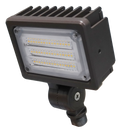
4 Products
LED flood lights are directional luminaires that project controlled light onto targets like façades, signs, loading areas, and sports courts. They balance output, beam shape, and aiming flexibility.
Use the NEMA beam scale: narrow (2×2–3×3) for long-throw accent/signage, medium (4×4–5×5) for façade wash, and wide (6×6–7×7) for general area fill with fewer hot spots.
Small signs and entries can use lower-wattage floods; large façades and yards need higher output. For long throws, prioritize CBCP (peak intensity) over total lumens. A photometric layout is the most reliable way to size fixtures.
Yoke/U-bracket for structure mounting and precise tilt; knuckle for compact heads on J-boxes; slipfitter for poles/tenons. Look for aiming scales and lockable hardware to prevent drift.
Select appropriate beam spreads, avoid upward tilt, and add shields, visors, or barn doors. Full-cutoff optics and house-side control keep light on target and out of windows/sky.
Yes—most are IP65+ wet-location with sealed optics. For harsh/coastal sites, specify NEMA 4X enclosures, marine-grade coatings, stainless hardware, and higher surge protection.
LEDs excel in cold weather. Verify the listed operating temperature range. If using emergency batteries, ensure the pack is rated for the site’s low ambient.
Yes. Many models include or support photocells for dusk-to-dawn and motion sensors with step-dimming. 0–10V dimming is common for fine control.
DLC-listed floods typically qualify for utility incentives. DLC Premium tiers often earn higher rebates—check your utility’s program.
Yes. Choose models with UL 924 battery backup, or connect to a life-safety circuit/generator to maintain the required 90 minutes of illumination (confirm with your local fire marshal or building inspector).
In areas with flammable vapors or dust, specify hazardous-location rated fixtures (e.g., Class I, Division 2). Standard floods aren’t suitable for these environments.
Large fields need high-output floods and low-flicker drivers. For video capture, look for flicker-free performance and beam shaping that avoids glare in the camera’s field of view.